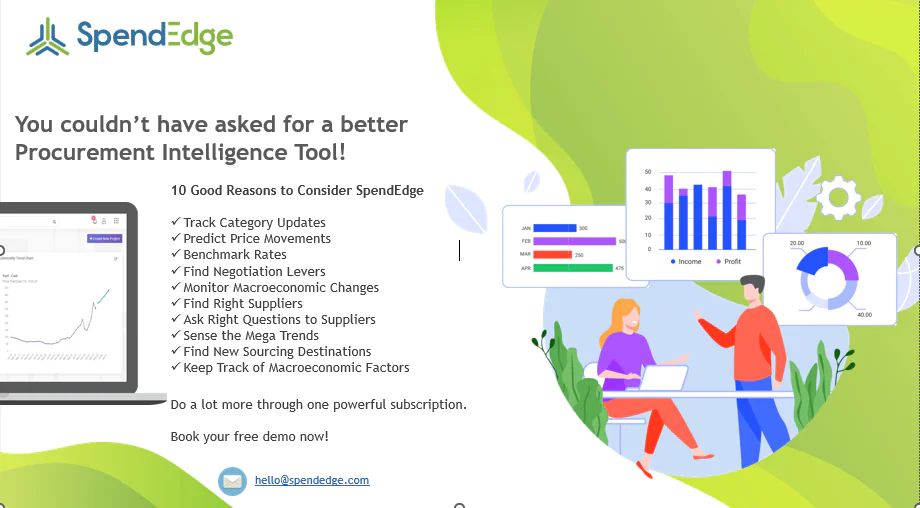Author: AVP, Sourcing and Procurement, SpendEdge
The Total Cost of Ownership (TCO) approach offers a more comprehensive method of evaluating costs, considering not only the upfront expenditure but also the long-term financial impact throughout a product’s lifecycle. By factoring in both direct and indirect costs—from raw materials and labor to maintenance and disposal—organizations can unlock significant savings and make more informed, strategic decisions. This blog explores the TCO approach in procurement and highlights how it can optimize spend, strengthen supplier relationships, and drive long-term value for businesses.
Total Cost of Ownership in Procurement Explained
The total cost of ownership (TCO) approach to evaluating an organization’s spending focuses on the long-term costs and expenses incurred over the useful life of a product, all the way up to its ultimate disposal. The direct costs that enter the TCO equation include raw material and component costs, salaries and wages paid to workers directly involved in product manufacturing, as well as cost of items incidental to the production of specific products. The cost of fixing or maintaining shop floor assets is another direct cost component under the total cost of ownership in procurement. The indirect side of the TCO spectrum comprises costs such as rentals of offices and warehouses, admin salaries, office supplies, and various fringe benefits. Usage-based costs such as of energy, water, and sewage, as well as internet and telecom are other instances of indirect TCO.
Initial purchase price today is like that plain vanilla, and the present-day life and times demand a more end-to-end take on product costs. Essentially, by considering spend analysis through the prism of TCO, procurement managers get a comprehensive view of all costs associated with the lifecycle of an asset. In sum, the TCO in spend analysis is arrived at after considering all pertinent costs – direct, indirect, and intangible, all included. With all relevant spend metrics at their fingertips, chief procurement officers (CPOs) can make more effective and evidence-based decisions. Read on to know more about why the total cost of ownership in procurement is topping the corporate agenda virtually everywhere.
Top 6 Benefits of a TCO-Based Approach in Procurement
Benefits of TCO-based procurement approach
- Identify New Cost-Saving Opportunities
- Strengthen Supply Chain Negotiations
- Enhance Purchasing Decisions
- Improve Budgeting and Forecasting
- Foster Sustainable Procurement Practices
- Enhance Supplier Relationships
Identify New Cost-Saving Opportunities
A TCO-based approach provides an aggregated view of product costs, enabling procurement professionals to identify additional areas for cost reduction. For example, a TCO analysis highlights opportunities for automating and standardizing procurement processes, reducing manual tasks, human errors, and redundancies. These improvements streamline workflows, cut down cycle times, and ultimately reduce costs.
Strengthen Supply Chain Negotiations
With detailed TCO analysis, procurement teams can consolidate purchases and negotiate better deals with suppliers. Backed by data on actual ownership costs, decision-makers gain leverage to secure volume discounts and favorable terms. Suppliers, aware of procurement teams’ TCO insights, are often incentivized to offer better quality products or services that reduce maintenance and servicing costs.
Enhance Purchasing Decisions
TCO analysis empowers procurement teams to make more informed purchasing decisions. By evaluating the lifecycle costs of a product—from purchase to disposal—CPOs ensure that the value derived from the asset justifies its cost. This lifecycle perspective enhances organizational decision-making, fostering smarter investments and sustainable outcomes.
Improve Budgeting and Forecasting
A TCO-based approach enhances budgeting and forecasting by providing a comprehensive view of long-term costs associated with products and services. By factoring in all lifecycle expenses, procurement teams can create more accurate budgets that reflect true costs rather than just initial purchase prices. This foresight helps organizations allocate resources more effectively and anticipate future financial needs, leading to better financial planning and stability.
Foster Sustainable Procurement Practices
Implementing a TCO framework promotes sustainability in procurement decisions. By evaluating the environmental impact and lifecycle costs of products, organizations can prioritize purchases that are not only cost-effective but also environmentally friendly. This includes selecting energy-efficient products or services that minimize waste and reduce carbon footprints, aligning procurement strategies with corporate social responsibility goals.
Enhance Supplier Relationships
A TCO analysis can significantly strengthen supplier relationships. By sharing insights from TCO evaluations, procurement teams can engage suppliers in discussions about quality improvements and cost reductions. This collaborative approach fosters transparency and trust, leading to more strategic partnerships. Suppliers may be more willing to innovate or offer better terms when they understand the long-term value their products provide, resulting in mutually beneficial arrangements.
Transform your procurement strategy by leveraging SpendEdge’s Total Cost of Ownership (TCO) analysis. Discover hidden cost-saving opportunities and enhance your purchasing decisions with data-driven insights that empower your organization to achieve sustainable financial performance...
SpendEdge’s TCO Analysis Solution
| Aspect | Description |
|---|---|
| Core Objective | Cost optimization is fundamental for enterprises, aimed at enhancing financial performance through strategic procurement practices. |
| Role of SpendEdge | SpendEdge specializes in identifying expenditure patterns and conducting comprehensive spend analysis, focusing on total cost of ownership (TCO) rather than just initial purchase costs. |
| Data-Driven Insights | Experts at SpendEdge utilize advanced tools to analyze historical expenditure data, uncovering hidden cost-saving opportunities that traditional methods may overlook. |
| Empowering Decision Makers | By providing precise data-driven methodologies, SpendEdge empowers Chief Procurement Officers (CPOs) and procurement leaders to make informed decisions that enhance their organization’s competitive standing and financial outcomes. |
| Strategic Actions | SpendEdge helps organizations identify inefficiencies in procurement processes and recommends strategic actions to optimize vendor relationships, negotiate better deals, and improve overall procurement efficiency. |
| Total Cost of Ownership Approach | The TCO approach employed by SpendEdge goes beyond conventional sourcing methods, allowing clients to discover new opportunities for cost reduction and enhanced procurement processes. |
| Impact on Competitive Standing | Collaborating with SpendEdge has enabled many organizations to improve their market competitiveness by effectively managing costs and optimizing procurement strategies. |
| Expertise in Cost Analysis | SpendEdge’s team conducts detailed cost modeling and analysis, capturing key cost drivers to enhance supplier productivity and ensure that procurement tasks remain within budget while realizing savings. |
| Client Success Stories | Numerous clients have successfully addressed their business challenges through SpendEdge’s insights, achieving improved profit margins, reduced operating costs, and enhanced product quality as a result of optimized procurement strategies. |
How SpendEdge Helped a Leading Consumer Business Boost Procurement Efficiency with a TCO-Driven Approach
Client Background
Our client is a recognizable name in the household cleaning products segment in North America with operations extending to several global markets. The company’s product lines include hand soaps, bathroom cleaners, multipurpose cleaners, bleaches, and oil-based cleaning concentrates, besides microfiber cloths and various cleaning tools.
Challenges Faced by the Client
Around the time the client turned to us for assistance, the business was trying to deal with a bunch of crucial issues in its procurement function. First things first. The household products business lacked adequate line of sight across various spend categories. One thing led to another. Low visibility of procurement data for various products gave rise to human errors, off-contract spending, workflow redundancies and delays. Spend overruns were the net effect and these were on the rise. The business struggled to identify cost opportunities lurking in its data blind spot.
Solutions Offered
Our team with years of experience in strategy support soon persuaded the client that it was in their best interests to shift from initial purchase cost analysis, a practice past its prime, to a more comprehensive one based on total cost of ownership in procurement. The former is just skin deep while the latter, as we all know, takes the entire product lifecycle into its sweep. In the process, it covers a lot of ground, from first-time purchase, deployment, and usage to final retirement! Our team next proceeded to conduct a thorough evaluation of procurement costs. All expenses associated with the products through their lifecycle entered the big picture. Even the so-called hidden costs weren’t spared!
Impact Delivered
Our efforts brought home the issues in the client’s procurement function and the importance of applying a healing touch without losing time. Our analysis, grounded in total cost of ownership in procurement, helped the client uncover waste and inefficiencies and reduce needless spending, thus making the most effective use of procurement spend. By identifying every single cost component associated with a certain product, our experts standardized the procurement processes around it. Our custom solution, predicated on TCO analysis, helped the client achieve substantial cost savings and significantly improve profit margins.
Read more: Analyzing Total Cost of Ownership (TCO) for Electric Vehicle Fleets

In conclusion, adopting a Total Cost of Ownership (TCO) approach in procurement enables organizations to gain a comprehensive understanding of all associated costs throughout a product’s lifecycle. By focusing on both direct and indirect costs, procurement leaders can uncover hidden savings opportunities, optimize supplier relationships, and make more informed, strategic purchasing decisions. This approach not only enhances financial forecasting and budgeting but also supports sustainable procurement practices. Embracing TCO analysis empowers businesses to improve operational efficiency, reduce waste, and ultimately strengthen their competitive advantage in an increasingly complex market landscape.
Are you ready to elevate your procurement function? With SpendEdge’s expert TCO analysis, you can streamline workflows, strengthen supplier relationships, and make informed budgeting decisions that reflect true lifecycle costs…




